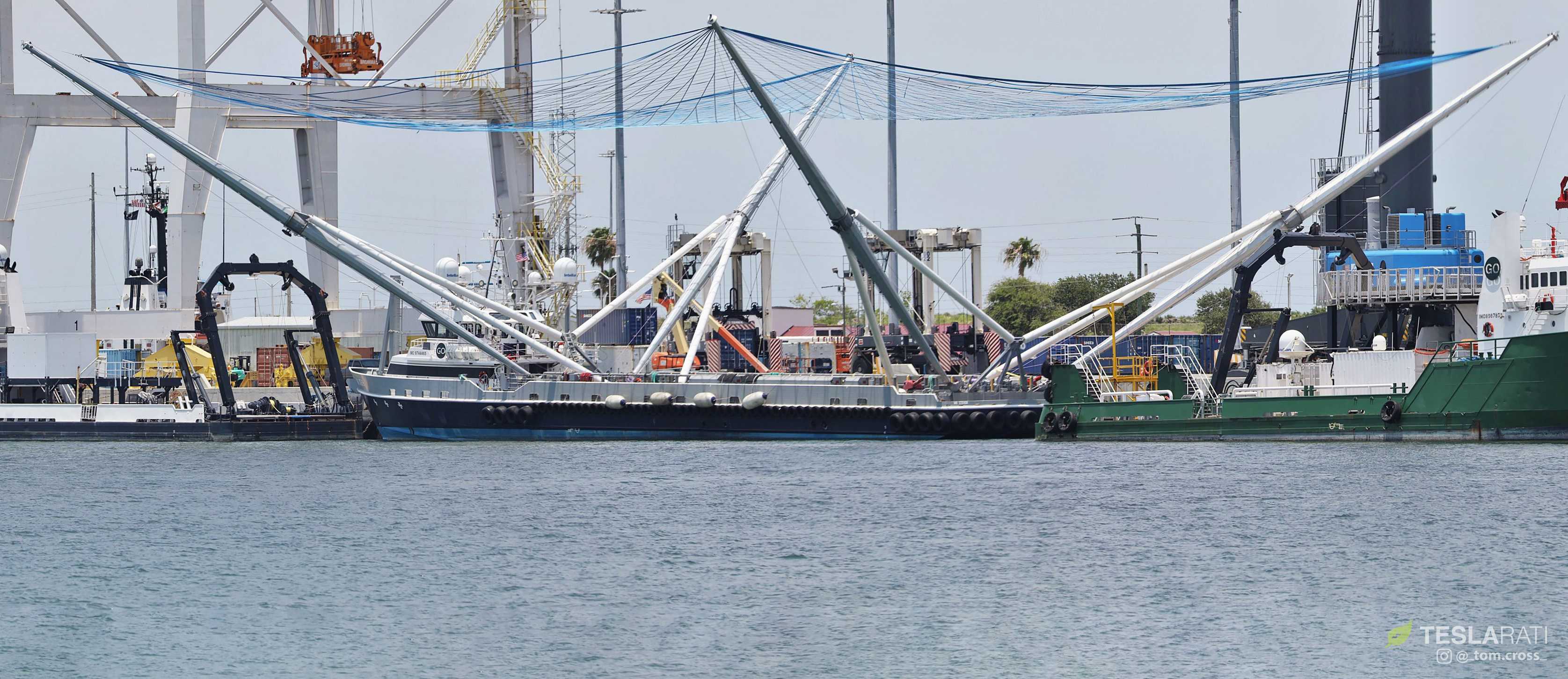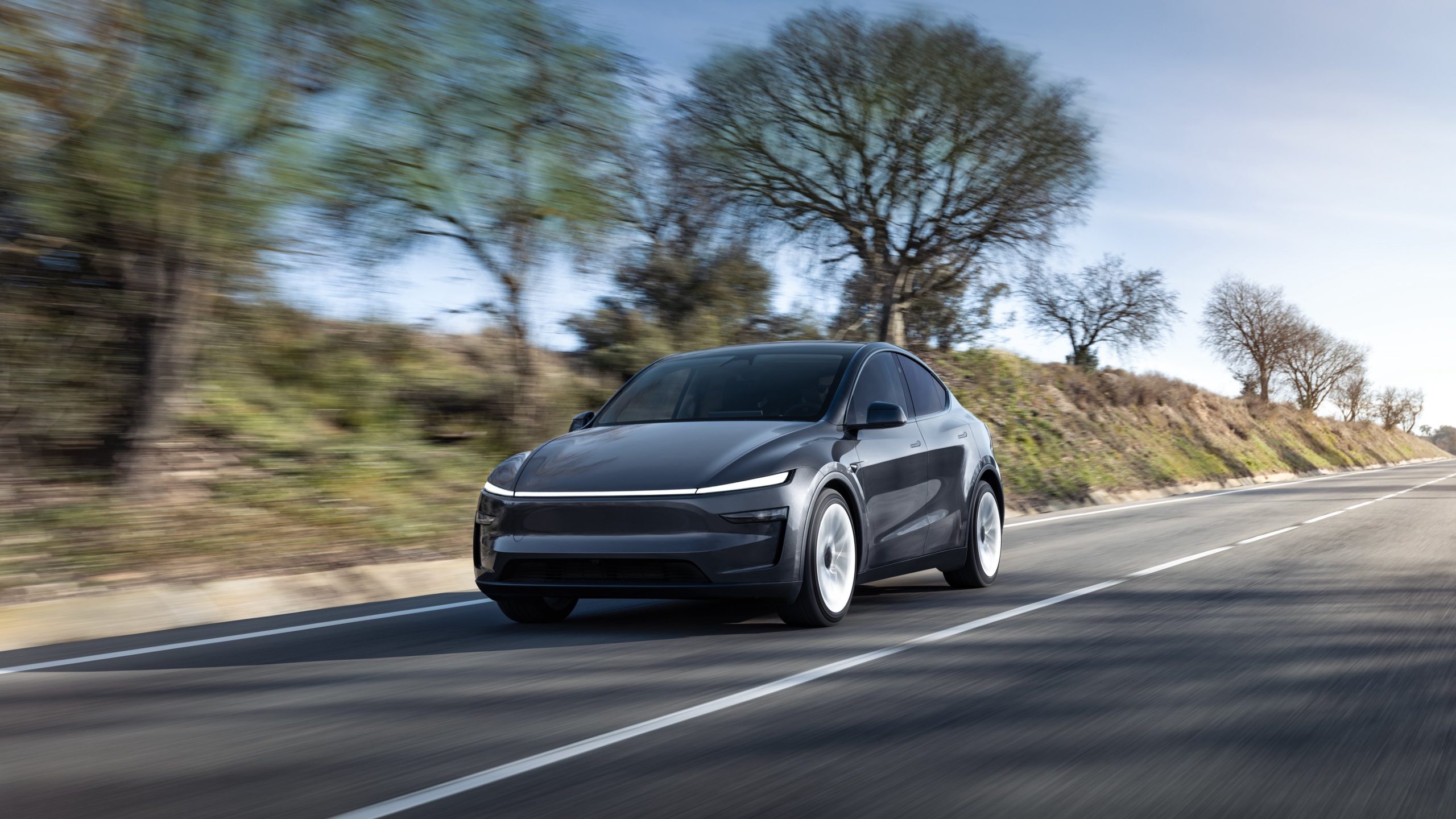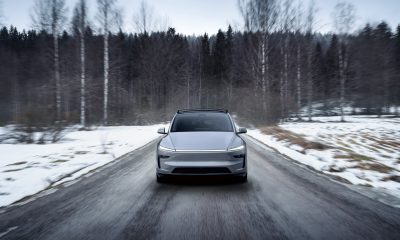

News
SpaceX’s Mr. Steven preparing for first Falcon 9 fairing catch attempt in months
SpaceX recovery vessel Mr. Steven has spent the last several weeks undergoing major refits – including a new net and arms – and testing the upgraded hardware in anticipation of the vessel’s first fairing catch attempt in more than four months.
Required after a mysterious anomaly saw Mr. Steven return to Port in February sans two arms and a net, the appearance of a new net and arms guarantees that SpaceX is still pursuing its current method of fairing recovery. Above all else, successfully closing the loop and catching fairings could help SpaceX dramatically ramp its launch cadence and lower costs, especially critical for the affordable launch of the company’s own Starlink satellite constellation.
The Saga of Steven
For a few months of 2019, it was entirely conceivable that SpaceX had all but given up on catching Falcon fairings, having spent the better part of 2018 without a single success during both post-launch and experimentally controlled catch attempts. Admittedly, a year may feel like a huge amount of time, but SpaceX has demonstrated just how hard the reliably successful recovery of orbital-class rocket hardware really is.
Depending on how one examines the history of Falcon 9, it took SpaceX anywhere from ~30 and ~70 months and either 7 or 9 failed recovery attempts before the first Falcon 9 booster successfully landed in December 2015. Excluding helicopter-based fairing drop tests, Mr. Steven and SpaceX’s fairing recovery team have made five attempts to catch fairings in the vessel’s net after Falcon 9 launches. All have been unsuccessful, with the closest miss reportedly landing in the Pacific Ocean just 50 meters away from Mr. Steven’s massive net.
In January 2019, Mr. Steven sailed ~8000 km (5000 mi) from Port of Los Angeles to Port Canaveral, passing through the Panama Canal. For unknown reasons, during a trip out to sea to catch a Falcon 9 fairing in February, Mr. Steven abruptly turned around early and arrived in port missing two of four arms, four of eight booms, and the entirety of its custom net. The remaining arms/booms were removed and the vessel spent roughly three months docked with just a handful of excursions.
In late May, technicians rapidly installed new arms and booms, as well as a new (and blue) net, bringing about the end of months of inactivity. Mr. Steven has yet to venture beyond the safety of Port Canaveral since its new ‘catcher’s mitt’ was installed, but SpaceX has been testing the new setup by repeatedly lowering a Falcon fairing half into the net. It’s too early to raise expectations but it seems plausible that the iconic recovery vessel will be ready to attempt its first fairing catch in ~4 months as part of Falcon Heavy’s next scheduled launch, currently NET June 22.
A challenger approaches…
Although Mr. Steven’s prospects look better than they have in months, SpaceX’s fairing recovery engineers and technicians have not been sitting on their hands. Begun as a check against the growing possibility that reliably catching fairings in a (relatively) small net is just too difficult to be worth it, SpaceX has been analyzing methods of reusing fairings without Mr. Steven. Most notably, despite the failure to catch fairings out of the air, the fairing halves themselves – relying on GPS-guided parafoils – have proven to be capable of reliably performing gentle landings on the ocean surface.
This consistently leaves the fairings intact and floating on the ocean but at the cost of partial saltwater immersion and exposure to surface-level sea spray and waves. At least in today’s era of highly complex large satellites, customers typically demand that payload fairings (like Falcon 9’s) offer a clean room-quality environment once the satellite is encapsulated inside. Sea water is full of salt, organic molecules, and water, all three of which do not get along well with extremely sensitive electronics. The whole purpose of recovering and reusing fairings is to make their reuse more efficient and less expensive than simply building a new fairing. The task of cleaning composite structures to clean room-standards after salt water exposure and immersion tends to be less than friendly to both aspirations.
According to SpaceX CEO Elon Musk, however, that challenge may be distinctly solvable and could even be easier than the Mr. Steven approach. After Falcon Heavy’s commercial Arabsat 6A launch debut in April 2019, Musk again confirmed that SpaceX would be ready to test that alternate method of fairing reuse very soon and plans to do so on an “internal” (i.e. Starlink) launch later this year. As noted below, this is helped by the fact that SpaceX’s internally-developed Starlink satellites apparently have no need for the acoustic insulation panels that normally protect sensitive spacecraft from the brutal acoustic environment produced by rockets while still in Earth’s atmosphere.
For fairing reusability, the lack of those panels is just one less thing to have to worry about cleaning or replacing. Intriguingly, it’s easy to imagine that – much like SpaceX has apparently designed Starlink satellites to be resistant to intense acoustic environments – the company could have also required that they be tough enough to tolerate a less-than-pristine fairing environment. With that approach, SpaceX could continue to build new fairings for every customer launch, entirely amortizing their production cost before transferring the ‘dirty’, flight-proven fairings to internal Starlink launches.
In essence, SpaceX’s customers would quite literally be paying the company to build the very Falcon 9 boosters and fairings it will ultimately use to launch its massive Starlink constellation, requiring hundreds of launches over the next decade. The faster and more efficiently SpaceX can build and launch Starlink, the faster it can develop Starship/Super Heavy and entirely transcend any concerns of salty fairings (let alone expendable upper stages). But in the meantime, Mr. Steven will return to his catching duties and SpaceX will continue to attempt to reuse payload fairings.
Check out Teslarati’s Marketplace! We offer Tesla accessories, including for the Tesla Cybertruck and Tesla Model 3.
News
Tesla UK sales see 14% year-over-year rebound in June: SMMT data
The SMMT stated that Tesla sales grew 14% year-over-year to 7,719 units in June 2025.

Tesla’s sales in the United Kingdom rose in June, climbing 14% year-over-year to 7,719 units, as per data from the Society of Motor Manufacturers and Traders (SMMT). The spike in the company’s sales coincided with the first deliveries of the updated Model Y last month.
Model Y deliveries support Tesla’s UK recovery
Tesla’s June performance marked one of its strongest months in the UK so far this year, with new Model Y deliveries contributing significantly to the company’s momentum.
While the SMMT listed Tesla with 7,719 deliveries in June, independent data from New AutoMotive suggested that the electric vehicle maker registered 7,891 units during the month instead. However, year-to-date figures for Tesla remain 2% down compared to 2024, as per a report from Reuters.
While Tesla made a strong showing in June, rivals are also growing. Chinese automaker BYD saw UK sales rise nearly fourfold to 2,498 units, while Ford posted the highest EV growth among major automakers, with a more than fourfold increase in the first half of 2025.
Overall, the UK’s battery electric vehicle (BEV) demand surged 39% to to 47,354 units last month, helping push total new car sales in the UK to 191,316 units, up 6.7% from the same period in 2024.
EV adoption accelerates, but concerns linger
June marked the best month for UK car sales since 2019, though the SMMT cautioned that growth in the electric vehicle sector remains heavily dependent on discounting and support programs. Still, one in four new vehicle buyers in June chose a battery electric vehicle.
SMMT Chief Executive Mike Hawes noted that despite strong BEV demand, sales levels are still below regulatory targets. “Further growth in sales, and the sector will rely on increased and improved charging facilities to boost mainstream electric vehicle adoption,” Hawes stated.
Also taking effect this week was a new US-UK trade deal, which lowers tariffs on UK car exports to the United States from 27.5% to 10%. The agreement could benefit UK-based EV producers aiming to expand across the country.
News
Tesla Model 3 ranks as the safest new car in Europe for 2025, per Euro NCAP tests
Despite being on the market longer than many of its rivals, the Tesla Model 3 continues to set the bar for vehicle safety.

The Tesla Model 3 has been named the safest new car on sale in 2025, according to the latest results from the Euro NCAP. Among 20 newly tested vehicles, the Model 3 emerged at the top of the list, scoring an impressive 359 out of 400 possible points across all major safety categories.
Tesla Model 3’s safety systems
Despite being on the market longer than many of its rivals, the Tesla Model 3 continues to set the bar for vehicle safety. Under Euro NCAP’s stricter 2025 testing protocols, the electric sedan earned 90% for adult occupant protection, 93% for child occupant protection, 89% for pedestrian protection, and 87% for its Safety Assist systems.
The updated Model 3 received particular praise for its advanced driver assistance features, including Tesla’s autonomous emergency braking (AEB) system, which performed well across various test scenarios. Its Intelligent Speed Assistance and child presence detection system were cited as noteworthy features as well, as per a WhatCar report.
Other notable safety features include the Model 3’s pedestrian-friendly pop-up hood and robust crash protection for both front and side collisions. Euro NCAP also highlighted the Model 3’s ability to detect vulnerable road users during complex maneuvers, such as turning across oncoming traffic.
Euro NCAP’s Autopilot caution
While the Model 3’s safety scores were impressive across the board, Euro NCAP did raise concerns about driver expectations of Tesla’s Autopilot system. The organization warned that some owners may overestimate the system’s capabilities, potentially leading to misuse or inattention behind the wheel. Even so, the Model 3 remained the highest-scoring vehicle tested under Euro NCAP’s updated criteria this year.
The Euro NCAP’s concerns are also quite interesting because Tesla’s Full Self-Driving (FSD) Supervised, which is arguably the company’s most robust safety suite, is not allowed for public rollout in Europe yet. FSD Supervised would allow the Model 3 to navigate inner city streets with only minimal human supervision.
Other top scorers included the Volkswagen ID.7, Polestar 3, and Geely EX5, but none matched the Model 3’s total score or consistency across categories. A total of 14 out of 20 newly tested cars earned five stars, while several models, including the Kia EV3, MG ZS, and Renault 5, fell short of the top rating.
Elon Musk
Why Tesla’s Q3 could be one of its biggest quarters in history
Tesla could stand to benefit from the removal of the $7,500 EV tax credit at the end of Q3.

Tesla has gotten off to a slow start in 2025, as the first half of the year has not been one to remember from a delivery perspective.
However, Q3 could end up being one of the best the company has had in history, with the United States potentially being a major contributor to what might reverse a slow start to the year.
Earlier today, the United States’ House of Representatives officially passed President Trump’s “Big Beautiful Bill,” after it made its way through the Senate earlier this week. The bill will head to President Trump, as he looks to sign it before his July 4 deadline.
The Bill will effectively bring closure to the $7,500 EV tax credit, which will end on September 30, 2025. This means, over the next three months in the United States, those who are looking to buy an EV will have their last chance to take advantage of the credit. EVs will then be, for most people, $7,500 more expensive, in essence.
The tax credit is available to any single filer who makes under $150,000 per year, $225,000 a year to a head of household, and $300,000 to couples filing jointly.
Ending the tax credit was expected with the Trump administration, as his policies have leaned significantly toward reliance on fossil fuels, ending what he calls an “EV mandate.” He has used this phrase several times in disagreements with Tesla CEO Elon Musk.
Nevertheless, those who have been on the fence about buying a Tesla, or any EV, for that matter, will have some decisions to make in the next three months. While all companies will stand to benefit from this time crunch, Tesla could be the true winner because of its sheer volume.
If things are done correctly, meaning if Tesla can also offer incentives like 0% APR, special pricing on leasing or financing, or other advantages (like free Red, White, and Blue for a short period of time in celebration of Independence Day), it could see some real volume in sales this quarter.
You can now buy a Tesla in Red, White, and Blue for free until July 14 https://t.co/iAwhaRFOH0
— TESLARATI (@Teslarati) July 3, 2025
Tesla is just a shade under 721,000 deliveries for the year, so it’s on pace for roughly 1.4 million for 2025. This would be a decrease from the 1.8 million cars it delivered in each of the last two years. Traditionally, the second half of the year has produced Tesla’s strongest quarters. Its top three quarters in terms of deliveries are Q4 2024 with 495,570 vehicles, Q4 2023 with 484,507 vehicles, and Q3 2024 with 462,890 vehicles.
-

 Elon Musk4 days ago
Elon Musk4 days agoTesla investors will be shocked by Jim Cramer’s latest assessment
-

 News1 week ago
News1 week agoTesla Robotaxi’s biggest challenge seems to be this one thing
-

 Elon Musk2 weeks ago
Elon Musk2 weeks agoFirst Look at Tesla’s Robotaxi App: features, design, and more
-

 News2 weeks ago
News2 weeks agoSpaceX and Elon Musk share insights on Starship Ship 36’s RUD
-

 News2 weeks ago
News2 weeks agoWatch Tesla’s first driverless public Robotaxi rides in Texas
-

 News1 week ago
News1 week agoWatch the first true Tesla Robotaxi intervention by safety monitor
-

 News2 weeks ago
News2 weeks agoTesla has started rolling out initial round of Robotaxi invites
-

 Elon Musk2 weeks ago
Elon Musk2 weeks agoTesla to launch in India in July with vehicles already arriving: report


















